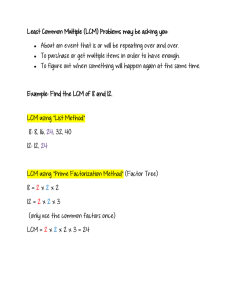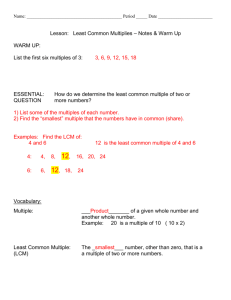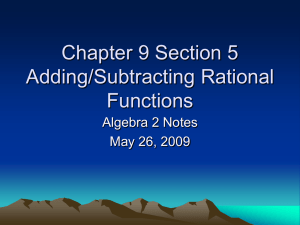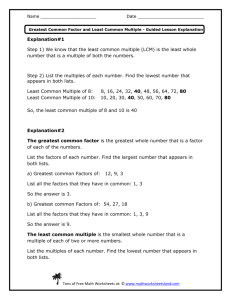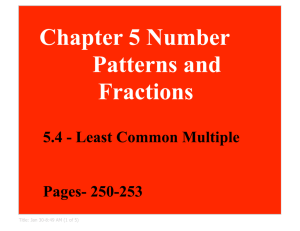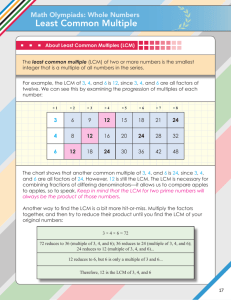DRAFT UNEP Life Cycle Management Training Kit Part II LCM as
advertisement
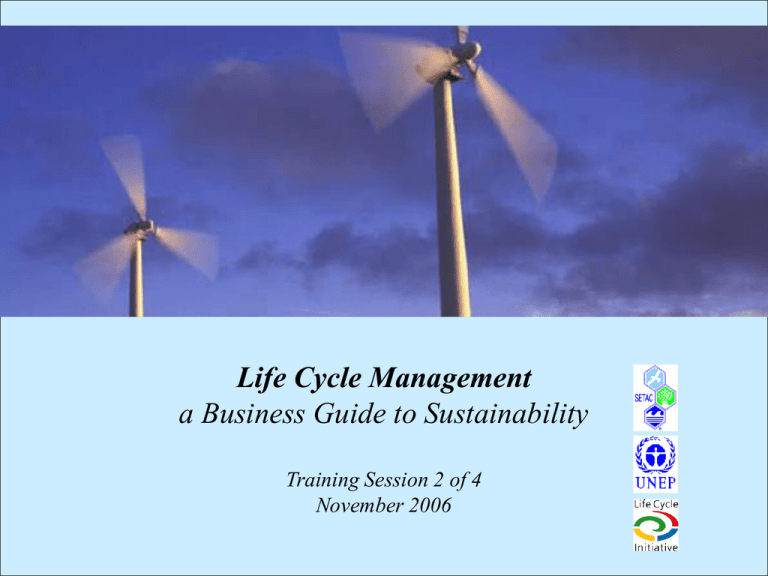
Life Cycle Management a Business Guide to Sustainability Training Session 2 of 4 November 2006 1 Life Cycle Management Training - Outline • Introduction to LCM – First session • How LCM is used in Practice – This session! • Communicating LCM Results – Third session • LCM and Stakeholder Expectations – Fourth Session 2 2 Learning Objective: Understand the theoretical basis of life cycle management & its history 08.00-08.30 Why LCM is needed in business and in government? Drivers 08.40-09.15 Introduction to LCM – Previous session What is a life-cycle? Impacts & value created along the life cycle of a product or service Definitions History Use 08.30-08.40 • What does LCM encompass? What are the unique aspects of LCM? 09.15-10.00 Group exercise 10.00-10.30 Break for coffee & refreshments done 3 3 Learning Objective: Understand the practical aspects of LCM in policy development & business operations, through discussions of how to integrate it into decision making & through case examples 10.30-10.45 Life cycle management • How LCM is used in Practice – This Session! Definition & Benefits 10.45-11.00 LCM involves… Learning from a range of examples 11.00-12.00 A process for implementing LCM Plan – Do – Check – Adjust A focus on design Further examples to illustrate 12.00-12.30 Group exercise 12.30-13.30 Break for lunch 4 4 Learning Objective: Provide a good understanding of communication tools and strategies. Why and how can they be valuable to business? 08.00-08.15 Why communicating LCM? To whom? Definition and scope, drivers, target groups of communication 08.15-09.00 Communication toolbox Main features and link with LCM Examples and diffusion of tools 09.00-09.45 • Communicating LCM Results – Third Session Case-studies Sector-specific drivers Communication strategies Combination of tools 09.45-10.00 Group exercise 10.00-10.30 Break for coffee & refreshments 5 5 Learning Objective: Understand how to identify stakeholders, as well as their priorities & concerns 10.30-10.35 Why Engage Stakeholders? 10.35-10.45 Identifying Stakeholders Potential Stakeholders Ask the right people Ranking 10.45-11.00 Importance of Including Stakeholders Risk Avoidance Opportunity Creation 11.00-11.45 Case example 11.45-12.30 Group exercise 12.30-13.30 Break for lunch • LCM and Stakeholder Expectations – Fourth Session 6 6 LCM as part of Good Practice Consider the following questions throughout this session: • • • • • What are the major obstacles to incorporating LCM into your organisation? Who in your organisation would you like to engage around a LCM initiative? What are the top five impact areas of your operations? Where are the greatest opportunities for your organisation in this area? What are the major risks for your firm and your industry in this area? 7 7 GETTING STARTED 8 8 Life Cycle Management is… … the application of life cycle thinking to business practices, with the aim to systematically manage the life cycle of an organisation’s products and services … the systematic management of product and material life cycles, to promote production and consumption patterns that are more sustainable than the ones we have today …a flexible integrated, management framework of concepts, techniques and procedures to address environmental, economic, and social aspect of products, procedures and organisations 9 9 LCM – Putting it into Practice • Objective • • Cornerstones 1. 2. 3. 4. • Understand fundamental elements & steps an organisation needs to get started putting LCM into practice Any organisation can apply LCM One doesn’t have to start at the top LCM involves all levels of an organisation Be sure to look beyond traditional boundaries How • Plan – Do – Check – Adjust to continually improve! 10 10 1. Any organisation can apply LCM 11 11 2. One doesn’t have to start at the top 12 12 3. LCM involves all levels of an organisation Life-cycle based environmental policy & product strategy From: Life Cycle Management - A Business Guide to Sustainability. UNEP/SETAC, 2007. 13 13 4. Look beyond traditional boundaries From: Life Cycle Management - A Business Guide to Sustainability. UNEP/SETAC, 2007. 14 14 Implementing LCM: the Plan-Do-Check-Act cycle Act Act Check Check Continuous Improvement Plan Plan Do Do From: Life Cycle Management - A Business Guide to Sustainability. UNEP/SETAC, 2007. 15 15 Implementing LCM: the Plan-Do-Check-Act cycle STEP ONE – PLAN • Set Policies • Organise • Survey & Research • Set Goals Plan 16 16 Implementing LCM: Plan-Do-Check-Act STEP ONE – PLAN • Set Policies – Ambition Level • Internal readiness/commitment to continuous improvement • Life cycle improvement of products • Environmental profiles of products • Organise • Survey & Research • Set Goals Plan 17 17 Implementing LCM: Plan-Do-Check-Act STEP ONE – PLAN • Set Policies • Organise • Survey & Research Ideas To Get Started • Ask all department heads • Where important issues lie • Where there are opportunities • What has been done in the past • Create a team of interested people • Set Goals Plan 18 18 Implementing LCM: Plan-Do-Check-Act STEP ONE – PLAN • Set Policies • Organise • Survey & Research – Environmental impacts – Market / commercial conditions – Partners There are two ways to get lost. One is not to know where you are going, the other is not to know where you are starting from - anonymous • Set Goals Plan 19 19 STEP ONE – PLAN Survey & Research key environmental impacts Material Cycle Input/Output Energy Use Input/Output Toxic Emissions Output Production and Supply of all Materials and Components In-house production Distribution Use Operation Servicing End-of-life system Recovery Disposal 20 20 Implementing LCM: Plan-Do-Check-Act STEP ONE – PLAN • • • • Set Policies Organise Survey & Research Set Goals – Relevance – Potential – Influence Plan 21 21 Implementing LCM: Plan-Do-Check-Act STEP TWO – DO • Make environmental improvements – put the plan into action • Report – document the efforts & their results Do 22 22 Implementing LCM: Plan-Do-Check-Act Do 23 23 Implementing LCM: Plan-Do-Check-Act STEP THREE – CHECK • Evaluate • Revise – revise policies and organisational structures as needed Do 24 24 Implementing LCM: Plan-Do-Check-Act STEP FOUR – ACT • Act. Adjust. Improve • Take it to the Next Level! Do 25 25 Implementing LCM: Plan-Do-Check-Adjust Continuous Improvement 26 26 Case Studies 27 27 Case Study – Mercedes S-Class Design • Considered the whole life cycle of the car including: – Production of materials and components – A service life of 300,000 km – Disposal • They considered 40,000 individual processes • They used a life cycle assessment software (Gabi 4.0) to consider 200 input and 300 output parameters 28 28 Case Study – Mercedes S-Class Mercedes Benz Environmental Certificate p. 16 ww.daimlerchrysler.com/Projects/c2c/channel/documents/776132_environmental_certificate_s_class_w221.pdf 29 29 Case Study – Mercedes S-Class • • • • • Results The first car with an environmental certificate Exceeds EU NOx and hydrocarbon emissions regulations by 85 and 75% Improved fuel efficiency and noise reduction Used water based paints to reduce solvent emissions Meets both 2006 and 2012 EU recycling rate requirements 30 30 Case Study – 3M Why is 3M using Life Cycle Management? • • • 3M produces close to 500 new products every year In the 1990s started managing all aspects of a product from idea phase through to use and disposal According to 3M’s CEO “[Life Cycle Management is] a commitment we must embrace to maintain our environmental leadership and to strengthen our competitive position” 31 31 Case Study – 3M How is 3M using Life Cycle Management? • 3M uses a matrix to identify the impact of products or processes over their entire life cycle 32 32 Case Study – 3M How is 3M using Life Cycle Management? • 3M uses a matrix to identify the impact of products or processes over their entire life cycle • They use this to identify both product risks and opportunities – Risks: hazards of the product, degree of uncertainty and feasibility to control exposure – Opportunities: address solutions to these issues 33 33 Case Study – BASF • BASF has “Socio-Eco-Efficiency Analysis” (SEEbalance®) tool • They use Eco-Efficiency Analysis or SEEbalance® for: – – – – – Strategic decisions on investments, products and markets. Comparison of production sites and markets. Prioritisation of research and product development. Discussion with opinion makers in political decisions. Marketing, support to external customers and social acceptance of products. – For communication issues e.g. corporate sustainability reports. 34 34 Case Study – BASF • The output of the tool provides BASF with comparisons of products on a number of criteria 35 35 Case Study – BASF • Success factors at BASF: – Top level commitment – Combination of LCA, LCC and social aspects. – Quantitative results with a clear assessment. – Simple and impressive illustration of results – Possibility of scenario- and sensitivity analysis – Short timeframe (2 month) and low costs for the analysis (<30,000 €). 36 36 Case Study – Green Management at SONY Goal Setting • Environmental performance goals are established in divisional annual business plans through to company wide long term goals • SONY uses an eco-efficiency equation to track progress Eco-Efficiency = Sales / Environmental Impact • Goals include: – – – – – Reduced product weight Reduce Number of parts used Increased proportion of recycled materials Banning of mercury and lead solders Use of halogen-free materials • Impacts are considered and tracked throughout their life cycle • They also support corporate social responsibility and have a supplier code of conduct 37 37 Case Study – Green Management at SONY Source: www.sony.net 38 38 Case Study – Hartmann Group • Produces egg, fruit, and industrial packaging mainly out of recycled paper • Have been using Life Cycle Management since 1997 • Developed and use the Systematic Tool for Environmental Progress or STEP®-model • Carry out LCA for all major products – Gives an overview of all environmental aspects and drives business decisions from planning to sales • In 2006 introducing a supplier assessment concept 39 39 Case Study - ABB • ABB has integrated sustainability into every aspect of its business including: – Product Development – Suppliers – Production – Material Flows and Wastes 40 40 Case Study – Procter & Gamble • • Produce a wide array of products from batteries to snack foods Assess the sustainability of products using their own Product Sustainability Assessment Tool PSAT – Social responsibility. • • • Risks and benefits for consumer/society. Human safety. Social responsibilities along the supply chain. – Environmental profile. • • • • Environmental safety. Solid waste management. Resource efficiency. Risk reduction efforts. – Economical development. • • Company economic aspects Consumer/society economic aspects 41 41 Case Study – Procter & Gamble • PSAT provides output metrics in the following forms 42 42 Case Study – Ciba Specialty Chemicals • Ciba has operations in 22 countries with a number of these in Less Developed Countries • They maintain an environmental, health, and safety standard that they apply to all of their operations regardless of where they are located • Covered by this are issues of: human rights, child labour, bribery, employee and community health and safety, as well as standard EHS considerations • Depending on the violation this may result in the termination of a contract or assistance to help the supplier meet the criteria 43 43 Case Study – Utz Kapeh Certified Responsible Coffee • Certifies socially and environmentally responsible coffee production and sourcing • Establishes a set of criteria for responsible and efficient coffee growing practices including: – Environmental: minimising and documenting use of agrochemicals, water management, and food safety – Social: protection of labour rights and access to health care and education for employees and their families 44 44 Case Study – Utz Kapeh Certified Responsible Coffee 45 45 Case Study – Sustainability-Driven Innovation Findings • 95% of companies believed it has the potential to bring business value • Almost 25% believed it would definitely deliver business value • This type of innovation is starting to offer real business value, but benefits are still intangible; • Leaders are now focussing on opportunities rather than just risks • A small minority of companies have integrated it into both their strategy and product/process design • A few companies are exploring breakthrough opportunities in Sustainability Driven Innovation 46 46 Case Study – Sustainability-Driven Innovation 47 47 Case Study – The Zabbaleen Cairo Egypt • Cairo produces 10-12,000 tons of waste/day • Zabbaleen collect waste door-to-door and earn an income by sorting recyclables out of waste Zabbaleens recycle 6090% of waste Contracted collection only recycle an average of 20% of waste 48 48 Case Study - Sayman & Danks Metal Finishing • Located in Durban, South Africa • Drivers – Regulatory Changes – Customer Demand • Activities – Reduced overall use of chemicals • Phased out toxic substances such as Chrome 6 – A 50% water reduction – In process of gaining ISO 9000 Certification • Results – Have gained a competitive advantage – See environmental performance as an opportunity – Have become an advocate of pollution prevention 49 49 Exercise: Reflecting on Your organisation 50 50 Describe a current initiative From: Life Cycle Management - A Business Guide to Sustainability. UNEP/SETAC, 2007. 51 51 Life Cycle Management is… … the application of life cycle thinking to business practices, with the aim to systematically manage the life cycle of an organisation’s products & services … the systematic management of product & material life cycles, to promote production & consumption patterns that are more sustainable than the ones we have today …a flexible integrated, management framework of concepts, techniques & procedures to address environmental, economic & social aspect of products, procedures & organisations 52 adapted from Background Report UNEP Guide to LCM – A bridge to Sustainable Products Feb 2006 52 Imagine a future initiative From: Life Cycle Management - A Business Guide to Sustainability. UNEP/SETAC, 2007. 53 53 CLOSING 54 54 Example: Implementation of EcoDesign in a Company with LCM 55 55 Impact Impact The Importance of Design Matl. Prod. Product A Use EOL Matl. Prod. Use EOL Product B 56 56 The Generic Stage-Gate Development Process Planning Company Goal & Policies G Conceptual Design G Detailed Design G Testing/ Prototype G Production Launch G Product Review Supporting Activities Source ISO/TR 14062: 2002 57 57 Eco-Design Eco-Design applies to existing or new products Adapt it to the life cycle profile of the product in question... But also to the company’s business strategy, culture & capabilities of the organisation 58 58 Eco-Design Environmental Assessment Product (System) Definition Life cycle Perspective Stakeholder Perspective Ecodesign Environmental Communication Source ISO/TR 14062: 2002 59 59 In Practice – Eco-Design Environmental Assessment Environmental Communication Ecodesign Life cycle Stakeholder Perspective Perspective Impact Product (System) Definition Matl. Prod. Use EOL 60 60 In Practice – Eco-Design Product (System) Definition Environmental Assessment Life cycle Perspective Stakeholder Perspective Ecodesign Environmental Communication 61 61 In Practice Eco-Design Environmental Assessment Product (System) Definition Life cycle Perspective Stakeholder Perspective Ecodesign Environmental Communication Durable goods, (e.g. appliances) – energy conservation Impact – elimination of toxic and other minor constituents that complicate maintenance and upgrades Matl. Prod. Use EOL Single-use, (e.g. diaper) Impact – biodegradability – elimination of any problematic materials after its disposal Matl. Prod. Use EOL 62 62 In Practice – Eco-Design Environmental Assessment Product (System) Definition Life cycle Perspective Stakeholder Perspective Ecodesign Environmental Communication 63 63 Life Cycle Management Training - Outline • Introduction to LCM – First session • How LCM is used in Practice – Second session • Communicating LCM Results – Third session • LCM and Stakeholder Expectations – Fourth Session 64 64

